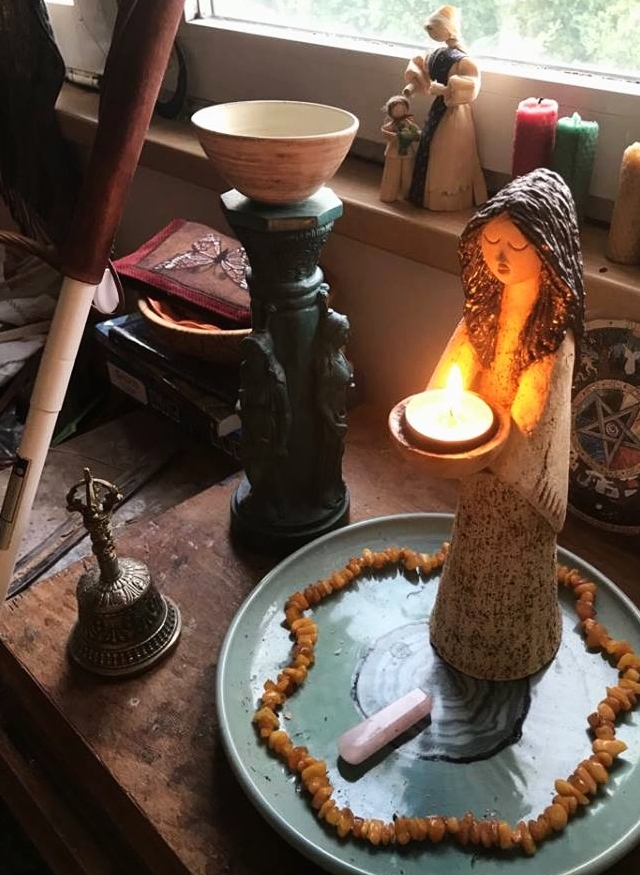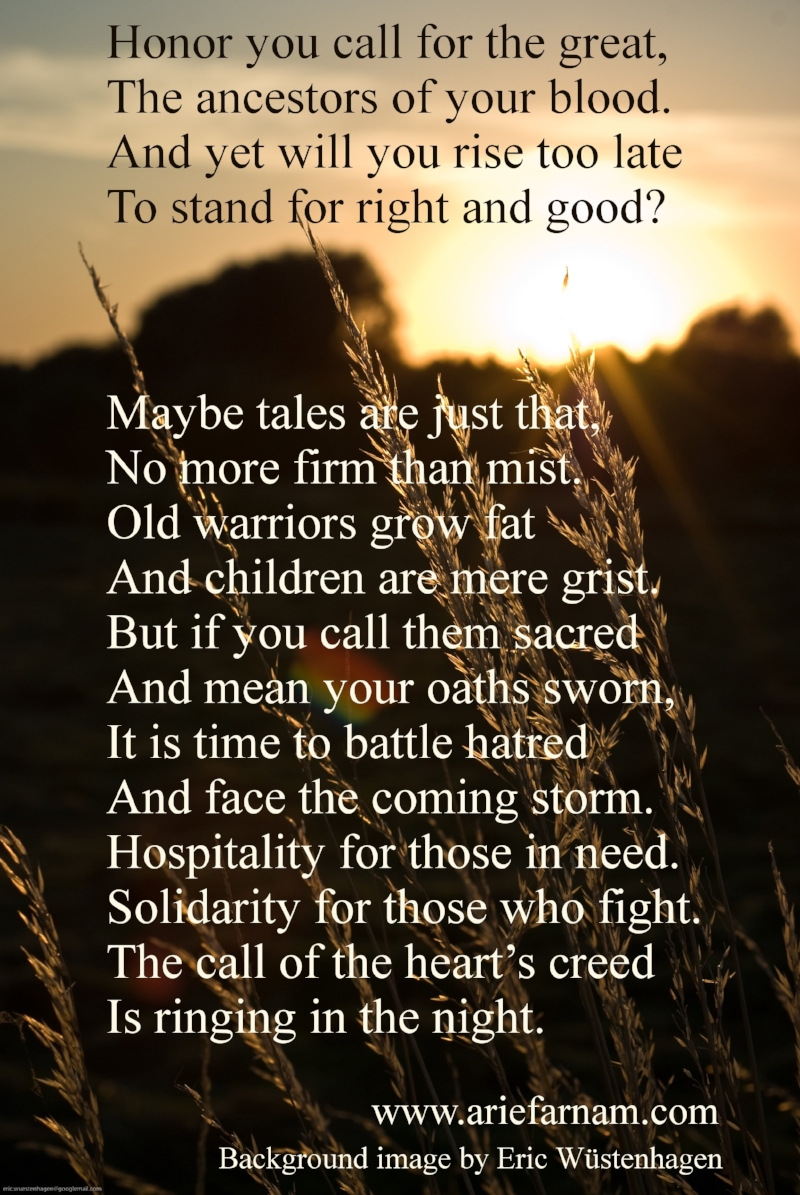Pagan means interconnection, reciprocity and community: A response to Rabbi Wolpe and The Atlantic
/Michele Reynolds, a Republican running for Congress in Ohio, was resoundingly denounced for trying to claim “jew you down” as a legitimate description for ruthlessly profit-seeking business dealings. Some people still use the lower-case term “gypsy” to mean a carefree, lascivious and irresponsible lifestyle or even “gyp” to mean stealing, but both terms are thankfully in decline. Black scholars have long railed against the use of “black” to mean everything evil, base or frightening.
We can all easily recognize these as instances in which the name of a racial, ethnic or religious group has been employed as a lower-case word with negative connotations. And yet, the December 25, 2023 issue of The Atlantic included an article by David Wolpe, a senior rabbi from Sinai Temple, that uses “pagan” as a synonym for the worship of wealth, ego and illegitimate power not once but repeatedly throughout the piece, and I haven’t heard any indication of concern from outside the Pagan community.
Defining modern or ancient Paganism as negative, fabricating false links between Paganism and Donald Trump, and supporting deceptive Nazi claims to Pagan symbols were the key points of Wolpe’s article. It had no other purpose, and as such, constituted hate speech under the US judicial definition.
Image of an ancient stone structure by Sinji and SaDIE via Flickr.com
Unfortunately, this isn’t the first time I’ve heard the word “Pagan” used and abused in this fashion, but it is telling that I’ve heard it more in the past two months than in the past twenty years. Even before the Atlantic article came out, an old friend wrote to me with concerns over my use of the term “Pagan” on this blog because of an assumption that it implies “idolatry… wealth, gluttony, and drunkenness.”
I grew up in a heavily conservative Christian area and when I was a child there was no possibility of naming our spiritual practices openly. At the time, we had no word for “Pagan.” It was the thing we didn’t name or speak of outside of a close circle. My mother legitimately feared she could lose her job if our family’s alternative spirituality was widely known. I have met many fellow Pagans who were bullied or beaten up when their beliefs were discovered, and I’ve read about the cases where children were taken away from Pagan parents without any reasonable cause.
But I did think things were improving. I may not be “out of the broom closet” the way some Pagans are in big, liberal cities—wearing pentacle or Mjolnir jewelry on a daily basis or bringing up Pagan identity in casual conversation—but I don’t hide it the way we once did. I have a large meditation altar in my living room and everybody who walks into my house should be able to get the general idea. I do wear a lot of Yggdrasil jewelry, which could be passed off as “just a pretty tree” in case of threats, and when there’s good reason and my family and I are not likely to be in direct danger, I’ll use the term Pagan publicly. And of course, I have this blog.
So, I am rather shaken and deeply troubled by Wolpe’s article in The Atlantic, which is such a brazen attack on a broad group of spiritual traditions apparently without any other purpose than to malign and defame all those who practice within it. And coming from a rabbi, it has an extra kind of sucker punch feel, because he really should know better, and because being co-outsiders in a small town, I always felt solidarity with Jewish friends.
After the Atlantic article came out a close family member who has often participated in Pagan-adjacent practices referred me to the article and sharply criticized me when I attempted to explain the false premise of defining the term “Pagan” with negative attributes from the outset. If this kind of defamation can have that dramatic of an effect on someone who was previously inclined to be friendly toward Pagan beliefs, I am disturbed to think how it is likely perceived by those with less access to context.
So, let’s look at the issue through Wolpe’s own words. There’s a clue from the get-go in the fact that Wolpe insists on using “pagan” with a small P. This is a linguistic sign employed in a wide variety of contexts to imply that one is not referring to a legitimate cultural group, but rather to an attribute. This is why Black writers often insist on capitalization and why, if and when the Roma use the term “Gypsy,” they capitalize it. Those who wish to dismiss and degrade those groups will often insist on keeping the lower case. It is similar with “Pagan” versus “pagan.”
In any legitimate set of journalistic or scholarly style guidelines, we all know the term should be capitalized when referring to a specific cultural or religious group. Wolpe’s use of small-P “pagan” to refer to ancient Greeks and Romans as well as to modern Pagans is a clear violation of professional style and likely an intentional slap in the face.
But you don’t have to look to semantics to find Wolpe’s glaring prejudice and false premise. In the first paragraph, he asserts that Donald Trump and Elon Musk are “more than a little bit pagan” because of their “wealth worship and ideological imperialism of ego.” He’s basically setting up his definition of terms here, while also using unpopular figures as a cheap way to sling mud. He later states his stereotype in the most direct possible of terms: “The current worship of wealth is a pagan excrescence.”
But defining Pagan as “wealth worship” is no different than defining Gypsy as “wild and dishonest,” Black as “primitive and frightening” or Jew as “greedy and ruthless.” It’s a blunt force stereotype used to begin a pseudo-philosophical discussion on a false premise in order to denigrate a particular group of people.
In reality, the term Pagan was first employed by Christians in fourth-century Rome to mean those who had not converted to Christianity and who continued to practice polytheist religions. In pure linguistics, the term meant “civilian,” “rural” or “rustic,” and it was likely adopted for this use because, at the time, the imperial and military power was Christian and it was primarily rural people who continued the old religion. It has been retroactively used to refer to polytheists in the biblical age when there were wealthy Pagan empires, including Rome before its Christian conversion, but it was not a term anyone at that time would have recognized.
That said, while we may retroactively apply the term “Pagan” to wealthy polytheist empires, that no more equates Paganism with the worship of wealth, empire or ego than it does to equate the teachings of Jesus with those same negative values because the Roman Empire was Christian for hundreds of years, the Austro-Hungarian Empire hinged on ostentatious displays of Christian wealth and the crowning of kings as “Holy Roman Emperor,” and the British Empire was explicitly founded on forced conversions to Christianity.
Wolpe offers no historical facts to back his equation of Paganism to the worship of power and wealth, but simply states glaring stereotypes, as if they were well-known facts, such as, “Wealth is a cover for, or a means to, the ultimate object of worship in a pagan society, which is power.”
While there have been empires employing Pagan and polytheist religions, it is impossible to defend a claim that these represented the majority of ancient Pagans. Had Wolpe used “imperial” in place of small-P “pagan” in every instance in his article, it would have actually made a great deal of sense. But then, that would have called up some troubling connotations about American—as well as other monotheist—imperialism.
Were there polytheist cults that went overboard on the worship of imperial rulers or which made the collection of ostentatious wealth part of the veneration of their gods? Archeology says "yes”—just as Christians built massive cathedrals, glittering with gold, at a time when the vast majority of the population in Europe was starving and just as the Jewish temples of Jesus’ time were being used to amass wealth. None of us can claim purity in this regard, but this is an aberration outside the core teachings in Paganism, as I believe it is in Christianity and Judaism as well.
Wolpe continues with a history lesson based on falsehood: “Most ancient pagan belief systems were built around ritual and magic, coercive practices intended to achieve a beneficial result. They centered the self. The revolutionary contribution of monotheism was its insistence that the principal concern of God is, instead, how people treat one another.”
Let’s take this apart step by step. First, the best way to see what “most ancient Pagan belief systems” were like is to look at the indigenous belief systems that have survived more in tact because they were colonized by monotheist empires more recently or not at all. The vast majority of ancient Pagans lived in tribal, rather than imperial societies. While much of ancient European tribal culture has been obscured by Christian conquest, scholars assert that the Celtic, Norse and other ancient European spiritual traditions bore a striking resemblance to Native American, African, Australian Aboriginal and other indigenous belief systems in which community, family, reciprocity, humility and respect for other living beings are primary values.
But what about Wolpe’s contention that Pagans both ancient and modern are all about “ritual and magic?” Many Pagans do tout the importance of one or both of these.
First, there is overlap between Witchcraft (often defined as the practice of magic outside of prayer) and modern Paganism. But there are also Christian, Jewish and atheist practitioners of Witchcraft today who will tell you they are not Pagan. And there are many Pagans who don’t practice magic of any kind. Witchcraft, like Buddhist meditation, is a self-help practice for most adherents. There are of course Wiccans and religious Buddhists who complicate this equation by making these practices their religions, but for many this is not the case.
Of course, some Pagans do practice a lot of ritual and ask for things they want in prayer to their deities. So do many monotheists. These are pretty much things you have to do in order to get tax exempt status as an official religion, if one were to apply for that. It is a bit ridiculous to say that because Pagans pray for beneficial outcomes to their problems and engage in religious ritual, that our practices are “coercive” and our beliefs “center the self,” more than those of monotheist religions. Rather, most Pagan traditions we know about both modern and ancient require practitioners to view their individual needs and wants in the context of an interconnected world, in which all deserve respect and in which the gods may not be able to heed your prayers precisely because there are other needs in the world.
I study the teachings of the Druid revival of the 18th century. In this tradition and in modern Druidry, the primary prayer is for knowledge and understanding, from which Druids believe other benefits flow. Such prayers are never without the real world follow-up of study and meditation. Another prayer included in most Druid ceremonies calls for peace in all corners of the world. There is nothing in these traditions that remotely resembles the negative image constructed by Rabbi Wolpe.
As for the claim that monotheism brought in a revolutionary idea about the kind treatment of others, that is part of a biblical myth but it isn’t grounded in fact. Indigenous societies have espoused ideals of selflessness, generosity, care for the sick, care for the natural environment, care for children and elders, care for strangers and travelers, as well as the reciprocal relationship between the wealthy and the poor for millennia. Ancient Greek sagas give concrete historical evidence of this and while many other traditions were not written down in ancient times, there is no evidence that these values were changed for the better by contact with monotheism. What remains of ancient European Pagan ethics comes through mythology, preserved sagas and through the Norse Eddas. Like the Bible, the Torah and the Koran these sources are a mixed bag when it comes to being kind versus cruel.
The Havamal, the portion of the Eddas most credited with giving ethical advice, is probably the best we have for reflecting ancient Pagan ideas of ethics the way the Bible, the Torah or the Koran does for Christians, Jews and Muslims. Here are a few quotes with verse number and translation cited:
“Fire he needs who with frozen knees has come from the cold without; food and clothes must the farer have, the man from the mountains come.” (3. Belllows)
“He craves for water, who comes for refreshment, drying and friendly bidding, marks of good will, fair fame if ‘tis won, and welcome once and again.” (4. Bray)
Image. of a candle shaped like a cat, a crystal sphere and other pagan decorations - image by Arie Farnam
In these passages, we clearly see the widespread Pagan values of generosity, hospitality and care for wanderers and the poor. Every modern indigenous tradition and every ancient Pagan canon of mythology includes stories and teachings which advise kindness, care for the vulnerable, offerings as sustenance for the poor, sharing and wealth redistribution. I have studied dozens of traditions and always come across these teachings in tribal societies. It is likely that this is no coincidence, since societies based on tribal and family groupings rely on these values for survival, while empires—whether Pagan, Christian or any other—often stray from values of reciprocity in favor of concentrated power and wealth.
“A man shall not boast of his keeness of mind, but keep it close in his breast; To the silent and wise does ill come seldom.” (6. Bellows)
Here we see the very common Pagan lesson on humility even in intellectual matters. The need for humility among the strong and able-bodied is also showcased in the legend of the defeat in mock battle of the strongest and most robust Norse god Thor by the ancient and frail goddess Ela, who carries the symbology of old age. It is not difficult to read into that the lesson that old age and infirmity come for even the strongest among us eventually and thus humility is wise.
“Not reft of all is he who is ill, for some are blessed in their children, some in their kin, and some in their wealth, and some in working well.” (69. Bray)
Here we can see that the ancient Norse valued wealth but also many other things. The passage doesn’t say which of these is the greater or the lesser. The point is rather that blessings come in many forms. It may be a call to gratitude, for even if one lacks health or family or wealth, there are other blessings to be thankful for. It may be a call for humility to those that do have some of these blessings, because one very rarely has them all.
This is just a tiny sampling of ancient Pagan teachings on issues of wealth, humility, sharing and the like. I’m not here to argue that all ancient Pagans were paragons of virtue, humility or selfless love for their fellow man. There are verses in the Havamal that imply women are all a bunch of schemers or in which might makes right.
But remember Wolpe was comparing Pagan teachings to monotheist belief systems where the god curses women for all time because one woman wanted knowledge, a man is ready to kill his child because god told him to, the god orders the annihilation of entire nations including all the women and children, slaves are ordered to submit to their masters, and the idea of one lord above all is repeated endlessly. But somehow Wolpe decided Pagans are the ones with the negative teachings about power, wealth and empire.
Next, Wolpe turns to the worship of physical beauty as a supposed Pagan value: “The Greeks taught that the rich and powerful and beautiful were favored by the gods.” This is not borne out by historical evidence. While there is the occasional mention that the gods bestowed a gift of beauty or wealth on this or that mythical hero or heroine, they were just as likely to punish pride and vanity. Of course, some people throughout history have viewed good fortune, wealth, beauty or talents as implying the favor of their god or gods and thus their personal superiority. But monotheists have fallen for this logical and ethical error as much as Pagans ever did.
Wolpe then digresses into a troubling section in which he implies that the Nazi obsession with blue eyes and blonde hair actually represented an objective standard of beauty, rather than their own biased and contradictory interpretation of the concept. He drags Paganism into it without any factual link and states, “The veneration of physical beauty, the Instagramization of culture, is pagan to its roots.” There is nothing in Paganism either modern or ancient about the adoration of physical beauty, though Pagans don’t explicitly shun the human body as some monotheists have. Both polytheists and monotheists have their examples of opulence in honor of gods and both have their examples of asceticism. This is just Wolpe again implying an underlying assumption of Paganism as a term with inherent negative connotations.
It is hard to conceive of why The Atlantic or anyone else would see Wolpe as an expert worth such high profile publishing, given that he cannot get even the most easily verifiable facts correct. He states for instance: “January 6 made Jacob Chansley, the “QAnon Shaman,’ with his bare chest and Norse headdress, instantly notorious.” (The emphasis is mine.) That a so-called scholar of any type would call Chansley’s headdress “Norse” in the age of easily accessible information is embarrassing to say the least. The Norse never had horns on their helmets. There have been cartoon representations of Vikings with horns on their helmets in pop culture, but this bears no resemblance to historical or archeological fact and a “scholar” really should look further than cartoons for their sources. On the contrary, it is Native American culture Chansley was misappropriating with the fur-lined and feather-ornamented headdress he wore for the insurrection. Some Native American groups did historically use ceremonial horned headdresses and several Native American writers have protested his misappropriation of their cultural symbols.
But Wolpe is on a roll and continues digging his hole into alternative facts: “The Norse were people of conquest, rape, and pillage, at least in the popular imagination.” Well, at least he admits that what he is basing his information on is actually “the popular imagination.” The Norse were no more or less a “people of conquest, rape and pillage” than the Christians or the Mongols. The Norse were not all Vikings, which was a small subculture akin to pirates in other eras. The vast majority of moderately educated people today know some or all of this, but somehow Wolpe is given a prominent publishing platform for his hate-filled rant of ignorance.
As the article progresses, there are hints of the grievances that underlie Wolpe’s tirade, such as his glib soundbite, “Hug a tree or a dollar bill, and the pagan in you shines through.” Could it be that what Wolpe really dislikes so strongly is the environmental movement?
Much of the latter part of the article is focused on equating the movement for ecological protection, as well as all Pagans, with an obscure quote by the animal-rights activist Peter Singer which appears to support euthanasia for children suffering from extreme pain or complete incapacity because they should have the same “right to mercy” as animals that are “put down.” This is Wolpe’s weird twist on the animist world view of many Pagans which holds that humans are not categorically superior to other living beings and that everything has a soul. It’s just about the only place where Wolpe actually touched on a real Pagan value, although in an extremely distorted manner.
Yes, most modern and ancient Pagan traditions as well as most indigenous belief systems share a sense of human kinship with the natural world. We do not see ourselves as elevated by an all powerful god as rulers of the natural world. We also do not see the gods as authoritarian rulers over us. The Pagan worldview is one of interconnection and reciprocity, rather than hierarchy, precisely the point that Wolpe spent the first part of the article missing.
So, what is the truth about Pagan views of the value of human life versus animal or plant life? Frankly, it varies widely, just as it does among monotheists. Some Pagans are vegetarian because they see animals as relatives. Other Pagans are not vegetarian precisely because we see all living things as interconnected and required to live off of the deaths of other beings, and we do not view animals as morally superior to plants.
That does not mean we devalue our own lives or the lives of other humans. Most Pagans accept that it is natural and right to protect life and particularly the lives of those who depend on you. That is why we would be more likely to fight for the life of a human child than for an insect. We owe human children a higher level of protection and nurture because of natural bonds. The same applies to animals we domesticate. Still, most modern Pagans are less likely than some monotheists today to see the deaths of certain human children as more tragic than others because we do not see those who are different from us as less worthy. Furthermore, we are humble and regretful about any need to take animal or plant life, rather than claiming it as our due as superior beings.
What strikes me in this is that Wolpe accuses Pagans of being self-focused and obsessed with power and hierarchy, but then is disturbed that we are insufficiently focused on the authority of an all-powerful god and insufficiently self-obsessed to see ourselves as superior to the natural world. The contradiction is telling and in combination with the countless factual inaccuracies, the article turns out to be one of the most embarrassing pieces of un-scholarship I’ve ever seen.
The Atlantic is no doubt swamped with angry letters from Pagans. While I don’t see anyone else concerned by this show of hate speech, the Pagan community is certainly worried and alarmed. Even so, my natural instinct toward outrage is humbled by the calm and compassionate responses of many Pagan leaders, such as Holli Emore, executive director of Cherry Hill Seminary, who sent a letter to Rabbi Wolpe inviting him to a conversation on the topic without any criticism or rancur over the hate-inciting rhetoric he employed. Wolpe replied dismissively that he is too busy for any such conversation and claimed he never directed his condemnation at any particular group of people.
Emore and others like her have shown admirable restraint in their responses to this open declaration of hate toward our community. I take a lesson in humility from them, but I remain worried about the impact of this type of manipulative message, in which the underlying definition of terms is the vehicle for hate and condemnation of an entire religious group. Had Jews or Muslims or Native Americans or Christians been the target, I would be deeply concerned as well. The history of where this kind of rhetoric all too often leads has not even had a chance to gather dust.















































